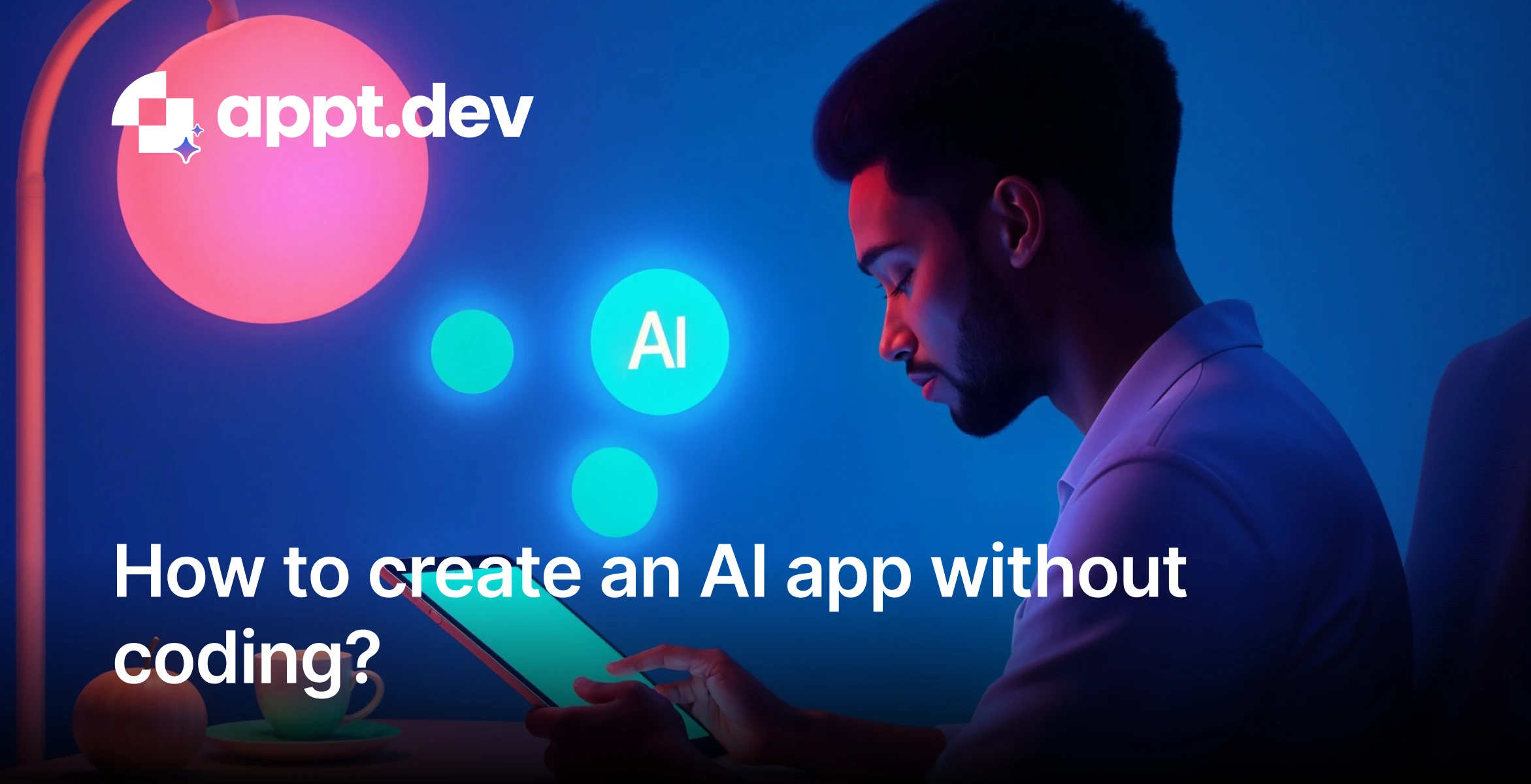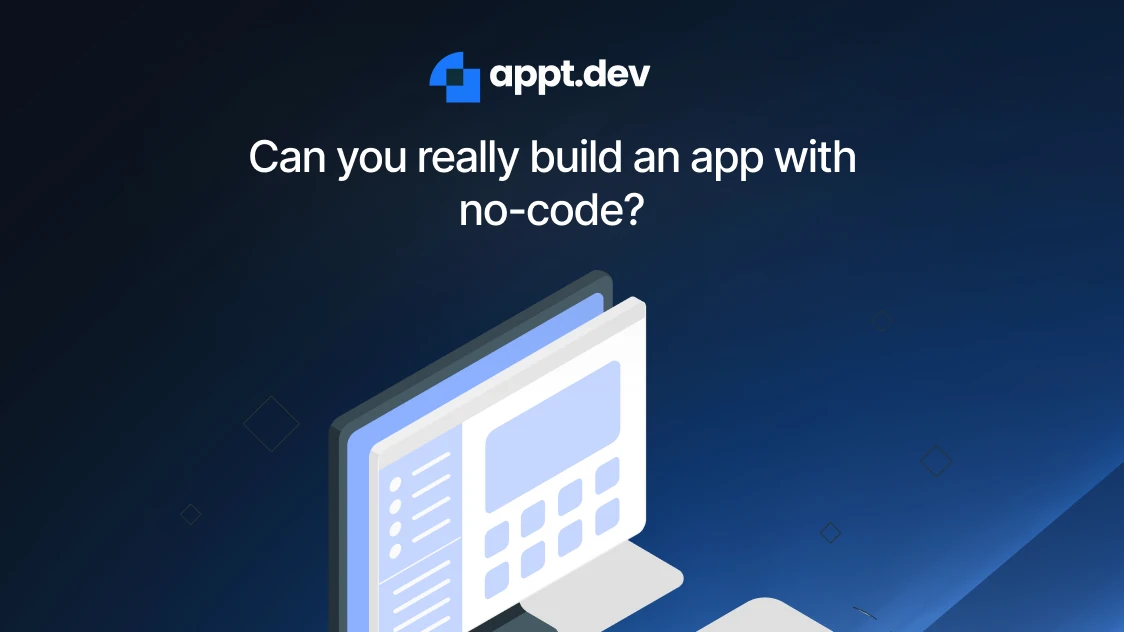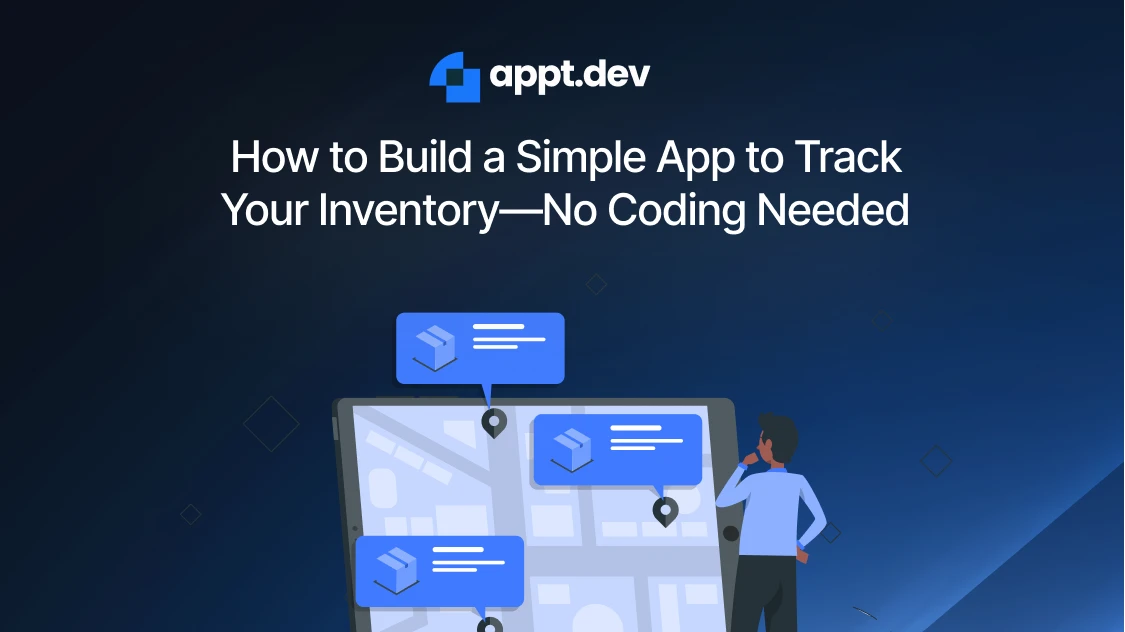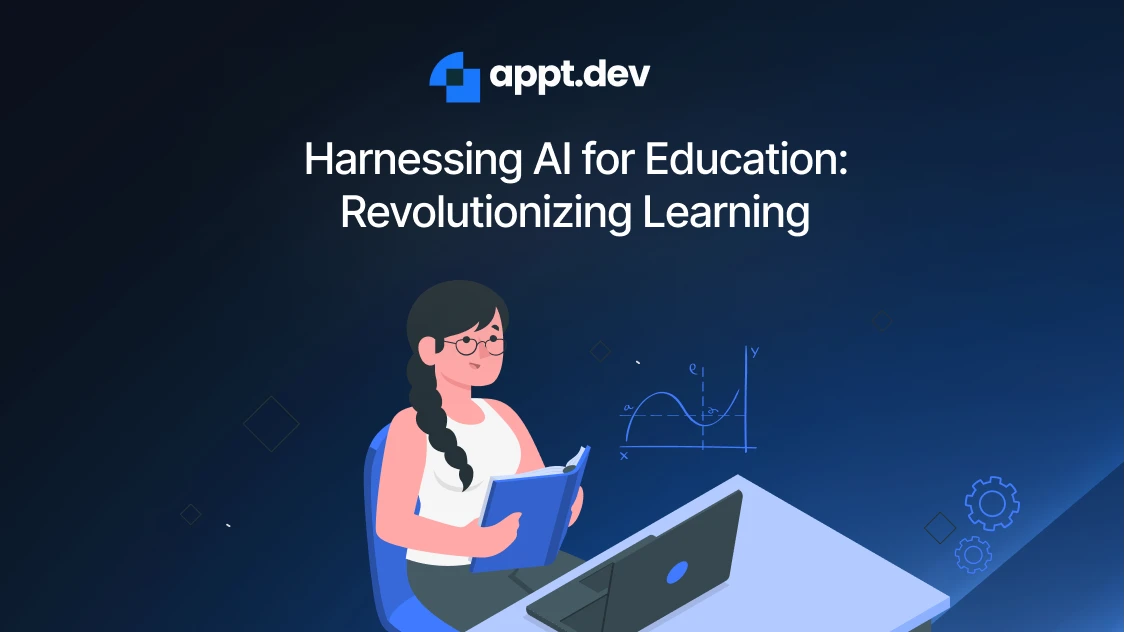How to create an AI app without coding?
Low-code

Abhijeet Chowdhury
May 23, 2025 | 4 min
Share to

In today's rapidly evolving technological landscape, artificial intelligence has transformed from an exclusive domain of specialized developers to an accessible tool for businesses and individuals alike. This comprehensive guide explores how anyone can create sophisticated AI-powered applications without writing a single line of code. With platforms like ApptDev leading the charge in AI-powered low-code development, you can now transform innovative ideas into functional applications in mere hours rather than months, saving significant time and resources while still achieving professional results.
Understanding Low-Code and No-Code Development for AI Applications
What Are Low-Code Tools?
Low-code development platforms are software solutions that minimize the need for traditional hand-coding by providing visual interfaces with drag-and-drop capabilities and simple logic. These platforms abstract complex programming concepts, making application development accessible to users with varying technical backgrounds1. The key components of low-code platforms typically include:
- Visual development environments with intuitive interfaces
- Pre-built templates and components for rapid deployment
- Drag-and-drop functionality for easy design and workflow creation
- Automated code generation capabilities
- Built-in integration features for connecting with other systems
- Cross-platform compatibility for diverse deployment options
According to recent market research, the low-code development platform market is projected to grow from $13.2 billion in 2020 to an impressive $45.5 billion by 2025, with a compound annual growth rate (CAGR) of 28.1%2. This remarkable growth reflects the transformative impact these solutions are having on the software development landscape.
The Difference Between Low-Code and No-Code Platforms
While often used interchangeably, important distinctions exist between low-code and no-code platforms that affect their suitability for different projects and user types:
Low-code platforms require some basic understanding of programming concepts but significantly reduce the amount of manual coding needed. They offer greater flexibility and customization options, making them suitable for developing complex, enterprise-grade applications. These platforms are ideal for teams that include both professional developers and business users who need to collaborate on sophisticated projects [1].
No-code platforms require absolutely no coding knowledge and typically offer simpler, more straightforward interfaces. While they excel at creating basic applications quickly, they may impose limitations on customization and complexity. No-code tools are perfect for business users with no technical background who need to create straightforward apps for specific purposes [1].
The distinction between these categories continues to blur, with many platforms offering capabilities that span both approaches to accommodate users with different skill levels and project requirements.
Benefits of Using Low-Code/No-Code AI Platforms
The integration of AI with low-code and no-code platforms has created powerful synergies that offer numerous advantages to organizations and individual creators:
Dramatically reduced development time: Build and deploy applications in days or even hours instead of weeks or months, allowing for rapid response to market opportunities [1].
Significant cost savings: Reduce development costs by up to 70% compared to traditional coding methods by eliminating the need for large specialized development teams [1] [3].
Democratization of app development: Enable non-technical team members to contribute directly to app creation, leveraging their domain expertise without requiring programming skills.
Rapid prototyping and iteration: Test ideas quickly and refine applications based on real user feedback, shortening the path from concept to viable product [1].
Seamless integration capabilities: Connect with existing systems and third-party services without complex coding, extending the functionality of your applications [1].
Enhanced scalability: Build applications that can grow alongside your business, accommodating increasing users and expanded functionality [1].
These benefits make low-code and no-code platforms increasingly attractive for organizations seeking to innovate quickly while managing development costs and addressing the persistent shortage of specialized development talent.
The Capabilities of AI in Modern App Development
How AI Is Revolutionizing App Creation
Artificial intelligence has fundamentally transformed the app development process, introducing automation and intelligence at every stage from initial design to deployment and maintenance. The integration of AI into low-code platforms represents a new paradigm that makes sophisticated app developme[3]nt accessible to virtually anyone [3].
Key ways AI is revolutionizing app creation include:
Automated code generation: AI can now translate natural language descriptions into functional code, eliminating the need for manual coding of common features and components[3].
Intelligent UI/UX design: AI-powered design assistants analyze user preferences and behavior patterns to create intuitive, engaging interfaces that enhance user experience[3].
Smart data processing and analysis: AI algorithms can automatically organize, clean, and analyze data from multiple sources, providing valuable insights and powering data-driven features.
Predictive analytics and personalization: Built-in AI capabilities forecast trends and user behavior, enabling more personalized app experiences that adapt to individual preferences[3].
Automated testing and optimization: AI identifies bugs, security vulnerabilities, and performance issues before they affect users, improving overall app quality and reliability[3].
Step-by-Step Guide to Creating an AI App Without Coding
Planning Your AI App: Defining Requirements and Objectives
Before diving into development, it's crucial to clearly define what you want your app to achieve. Start by answering these key questions:
What problem will your app solve? Identify the specific challenge or opportunity your application will address.
Who is your target audience? Define the primary users of your app and understand their needs and preferences.
What core features will your app need? List the essential functionalities required to meet your objectives.
What AI capabilities will enhance your app? Consider how artificial intelligence can provide unique value to your users.
What are your success metrics? Define how you'll measure your app's performance and impact.
Creating a detailed requirements document will serve as your roadmap throughout the development process. Even though you're using a low-code platform, thorough planning is still essential for success and will ultimately save time during the development phase.
Choosing the Right Low-Code/No-Code AI Platform
With numerous platforms available, selecting the right one for your specific needs is crucial. Here are key factors to consider when evaluating low-code/no-code AI app builders:
AI capabilities: Look for platforms with robust, built-in AI features that align with your requirements, such as natural language processing, computer vision, or predictive analytics.
Ease of use: Consider the learning curve and whether the platform's interface suits your team's skill level, especially if non-technical users will be involved[1].
Customization options: Ensure the platform offers sufficient flexibility to create a unique, branded experience that meets your specific needs.
Integration capabilities: Check whether the platform can connect seamlessly with your existing systems and third-party services to extend functionality[1].
Scalability: Consider whether the platform can accommodate growth in users and functionality as your app evolves and your user base expands1.
Support and resources: Evaluate the availability of documentation, tutorials, community resources, and direct support options.
Pricing structure: Look for transparent pricing that aligns with your budget and expected ROI, considering both initial and ongoing costs [1] [3].
Designing Your App's User Interface
The user interface is the face of your application and plays a crucial role in determining user satisfaction and engagement. Modern low-code platforms offer various approaches to UI design that require no coding experience:
Pre-built templates and themes: Start with professionally designed templates that you can customize to match your brand identity. Drag-and-drop interface builders: Visually construct your app's screens by dragging UI elements into place, arranging layouts intuitively [1].
Responsive design tools: Ensure your app looks and functions well on various devices and screen sizes for a consistent user experience. Component libraries: Access pre-built, customizable UI components like buttons, forms, cards, and navigation elements.
AI-assisted design recommendations: Receive intelligent suggestions for improving usability and aesthetic appeal based on design best practices[3].
When designing your interface, focus on creating intuitive navigation, maintaining visual consistency, optimizing for all device types, and ensuring accessibility for all users. Even without coding skills, these visual design tools allow you to create professional, engaging interfaces that drive user adoption.
Implementing AI Features in Your App
This is where the power of AI-enhanced low-code development truly shines. With modern platforms, you can implement sophisticated AI capabilities without writing complex algorithms or training models from scratch[3].
Here are some of the AI functionalities you can easily add to your app:
Natural Language Processing (NLP): Enable your app to understand and respond to human language, powering features like chatbots, content analysis, and language translation[3].
Computer Vision: Incorporate image recognition, object detection, and visual search capabilities, similar to the BREAST AI application that provides efficient diagnosis of breast cancer through ultrasound scan analysis [4].
Predictive Analytics: Implement forecasting, recommendation systems, and personalized content delivery based on data patterns3. Machine Learning Workflows: Create decision-making systems that learn and improve over time with increasing data[3].
Voice Recognition and Processing: Add voice commands and dictation features to enhance accessibility and user convenience.
The implementation process typically involves selecting the desired AI functionality from your platform's library, configuring the parameters according to your needs, connecting the AI component to your data sources, and testing the functionality with sample data.
Testing and Deployment
Once you've built your app, thorough testing is essential to ensure it functions correctly and provides a positive user experience. Most low-code platforms include built-in testing tools that help you identify and resolve issues before deployment:
Automated testing: Run comprehensive tests across different devices and scenarios to identify potential problems[3].
Performance analysis: Identify bottlenecks and optimization opportunities to ensure your app runs smoothly[3].
Security validation: Ensure your app meets security best practices and compliance requirements to protect user data[3].
User experience testing: Simulate real user interactions to refine the user journey and identify areas for improvement.
After successful testing, deployment is typically straightforward with low-code platforms, often requiring just a few clicks to publish your app to web and mobile platforms. Modern platforms handle the complex aspects of deployment, including packaging, optimization, and distribution across multiple platforms simultaneously.
Factors to Consider When Selecting a Platform
When evaluating which platform is right for your specific AI app project, consider these critical factors:
Project complexity: More complex applications with unique requirements may need platforms with greater customization capabilities and deeper AI integration options.
Technical expertise available: Match the platform's complexity to your team's skills; some platforms are designed for complete beginners while others assume some technical knowledge[1].
Deployment requirements: Consider whether you need web-only deployment or cross-platform capabilities including iOS, Android, and desktop environments.
Integration needs: Evaluate how well each platform connects with your existing systems, databases, and third-party services[1].
Scalability requirements: Consider your anticipated user growth and whether the platform can scale efficiently to handle increased load[2].
Budget constraints: Balance feature needs against cost considerations, including both initial implementation and ongoing subscription fees[3].
Support and community: Assess the availability of learning resources, community forums, and direct support options, which can significantly impact your success with the platform.
By methodically evaluating these factors against your specific requirements, you can identify the platform that offers the optimal balance of capability, ease of use, and cost-effectiveness for your AI app project.
Real-World Applications and Success Stories
Industry-Specific AI App Use Cases
Low-code AI applications are making an impact across virtually every industry. Here are some notable examples by sector:
Healthcare:
- Diagnostic assistance tools like BREAST AI, which provides efficient diagnosis of breast cancer via ultrasound scans without requiring internet connectivity, achieving 87.50% testing accuracy in clinical evaluation[4].
- Patient triage and symptom assessment applications that use AI to prioritize care delivery.
- Remote patient monitoring platforms that leverage AI for early warning of potential complications.
Finance and Banking:
- Fraud detection systems that analyze transaction patterns to identify suspicious activity in real-time.
- Personalized financial planning tools that provide AI-driven recommendations based on individual financial situations.
- Automated loan approval applications that assess risk and make decisions more efficiently than manual processes.
Retail and E-commerce:
- Personalized shopping recommendation engines that increase conversion rates and customer satisfaction.
- Inventory optimization systems that predict demand patterns and recommend stock levels.
- Visual search applications that allow customers to find products by uploading images.
Manufacturing:
- Predictive maintenance applications that forecast equipment failures before they occur.
- Quality control systems that use computer vision to detect defects with greater accuracy than human inspection.
- Supply chain optimization platforms that adapt to changing conditions in real-time.
In each of these industries, low-code platforms are democratizing access to AI technology, allowing domain experts to create specialized applications without extensive technical knowledge[3].
Business Impact and ROI Analysis
The financial and operational benefits of low-code AI app development are compelling, as demonstrated by quantitative results from various implementations:
Development Time Reduction:
- Traditional development typically requires 6-12 months for complex AI applications
- Low-code development can reduce this to 1-3 months
- This represents an average time savings of 75%[3]
Cost Efficiency:
- Traditional AI app development often costs between $60,000 and $150,000
- Low-code approaches can reduce this by 50-70%
- Small businesses particularly benefit from this cost reduction, making sophisticated AI capabilities accessible at a fraction of traditional development costs[3][2]
Business Impact Metrics:
- Average ROI timeframe of 3-6 months for low-code AI applications
- Process efficiency gains averaging 30-50% through automation of manual tasks
- Customer satisfaction increases of 15-30% through more personalized experiences
- Revenue growth of 10-25% through faster innovation and market response[3]
These metrics highlight the substantial advantages of low-code development for both technical and business outcomes. By dramatically reducing time-to-market and development costs while maintaining high quality, low-code platforms enable organizations to experiment more freely and respond more quickly to changing market conditions.
Future Trends in AI App Development Without Coding
Emerging Technologies Shaping the Future
Several emerging technologies are poised to significantly impact the future of AI app development without coding:
Generative AI: Advanced language and image generation models will further enhance the capabilities of low-code platforms, enabling more sophisticated content creation, code generation, and design assistance directly from natural language descriptions[3].
Automated Machine Learning (AutoML): As AutoML technologies mature, they will enable automatic selection, training, and optimization of AI models for specific use cases without requiring data science expertise, further democratizing advanced AI capabilities[3].
Edge AI: The ability to run AI models directly on devices rather than in the cloud, as demonstrated by the BREAST AI application that operates without internet connectivity, will become increasingly important for applications requiring real-time processing, privacy, or offline functionality[4].
Multimodal AI: Systems that can process and understand multiple types of input (text, images, audio, video) simultaneously will enable more natural and versatile user interactions in low-code applications4. Federated Learning: This approach allows AI models to be trained across multiple devices while keeping data private, opening new possibilities for privacy-preserving AI applications developed through low-code platforms[3].
These technologies will expand the capabilities of low-code platforms, enabling even more sophisticated applications to be created without traditional coding while addressing current limitations related to customization, performance, and advanced AI functionality.
Predictions for Low-Code/No-Code Market Evolution
Based on current trajectories and industry research, we can anticipate several key developments in the low-code/no-code AI app development market:
Continued market expansion: The low-code development platform market, already projected to reach $45.5 billion by 2025, will likely continue its rapid growth as adoption spreads across industries and organization sizes[2].
Increasing enterprise adoption: Large organizations will increasingly adopt low-code platforms for mission-critical applications, driving maturity in governance, security, and scalability features to meet enterprise requirements[2].
Specialized vertical solutions: We'll see the emergence of more industry-specific low-code platforms optimized for particular sectors like healthcare, finance, or manufacturing, with pre-built components tailored to those industries' unique needs.
Greater AI accessibility: The capabilities that currently require specialized AI expertise will become increasingly accessible through intuitive interfaces, allowing non-technical users to implement advanced AI features like computer vision, natural language processing, and predictive analytics[3].
Convergence with traditional development: The boundaries between low-code development and traditional coding will continue to blur, with platforms offering seamless transitions between visual development and code customization to accommodate projects of varying complexity[3].
These trends point to a future where AI app development becomes increasingly accessible to non-technical users while simultaneously offering more sophisticated capabilities, fundamentally transforming how organizations approach software creation and innovation.
Getting Started with Your First AI App Project
Defining Your App Concept and Requirements
Before selecting a platform or beginning development, take time to clearly define your app concept and requirements:
Identify the problem: Clearly articulate the specific problem your app will solve or the opportunity it will address.
Define your target users: Create detailed user personas to understand who will use your app and what they need.
Outline core features: List the essential functionalities your app must have to meet user needs, distinguishing between "must-have" and "nice-to-have" features.
Identify AI opportunities: Determine where AI can add unique value, whether through personalization, automation, prediction, or analysis.
Set success metrics: Define specific, measurable goals for your app, such as user acquisition targets, engagement metrics, or business outcomes.
This planning phase is crucial even when using low-code platforms, as it will guide your development decisions and help you select the most appropriate platform for your specific needs.
Resources for Learning and Support
As you embark on your AI app development journey, take advantage of these resources to accelerate your learning and improve your results:
Platform documentation and tutorials: Most low-code platforms offer comprehensive documentation, video tutorials, and step-by-step guides specifically designed for beginners.
Community forums: Engage with user communities for your chosen platform to share experiences, ask questions, and learn from others who have built similar applications.
Online courses: Many platforms offer structured courses that walk you through the process of building different types of applications from scratch.
Sample applications and templates: Study and modify existing apps and templates to understand best practices and accelerate your development.
Webinars and events: Attend virtual or in-person events focused on low-code development to learn about new features and connect with experts.
Professional support services: Consider leveraging professional services offered by platform providers for guidance on complex projects or specialized requirements.
By actively utilizing these resources, you can overcome common challenges, avoid pitfalls, and significantly accelerate your learning curve.
The ApptDev Advantage in Modern Development
ApptDev exemplifies the next generation of low-code platforms with its unique combination of AI-assisted tools and enterprise-grade capabilities. The platform's visual programming environment features drag-and-drop workflows and one-click deployment, enabling teams to bypass traditional development bottlenecks. Key differentiators include:
- Figma-to-App Conversion: Direct import of UI designs from Figma files while retaining design systems and component variants
- Schema Designer: Visual data modeling tool with AI suggestions for optimal database structures
- Flow Designer: No-code workflow automation for complex business logic
- Appt Managed: Automated infrastructure scaling and performance monitoring
These features enable rapid prototyping while maintaining production-ready standards, with documented cases of organizations deploying three enterprise applications in under 30 days using ApptDev's tools
Rapid Prototyping with ApptDev's Visual Tools
ApptDev streamlines the app creation process through its integrated toolset:
- AI-Assisted Data Modeling: Use Schema Designer to define database structures through visual diagrams rather than SQL
- Workflow Automation: Connect screens and business logic using Flow Designer's node-based interface
- Real-Time Collaboration: Multiple team members can simultaneously work on different app components
- Instant Deployment: Push applications to production with one-click cloud deployment across web and mobile platforms
ApptDev: The Enterprise-Grade Solution
Among leading platforms, ApptDev stands out for balancing accessibility with technical robustness:
- Architecture: Cloud-native platform supporting microservices and high availability deployments
- Integration: Native connectors for Google Cloud, AWS, and Azure services
- Security: Enterprise-grade compliance with SOC 2 and GDPR standards
- Pricing: Transparent subscription model with free tier for small projects
Conclusion: Democratizing Development with ApptDev
ApptDev embodies the future of AI app creation by merging accessibility with technical sophistication. Its visual tools and managed infrastructure enable both technical and non-technical users to participate in application development while ensuring enterprise-grade outcomes. As demonstrated by healthcare implementations and rapid enterprise deployments, ApptDev successfully bridges the gap between prototype experimentation and production-scale delivery.
For organizations seeking to harness AI without coding complexity, ApptDev offers a compelling solution that reduces development costs by up to 70% while accelerating time-to-market. The platform's continuous innovation in areas like Figma integration and AI-assisted workflow design positions it as a leader in the evolving low-code landscape.
Citations:
- No-Code AI App Builder Free
- Low-Code Development Platform Market Worth $45.5 Billion by 2025 - Exclusive Report by MarketsandMarkets
- How to Create App with AI: Exploring AI App Builders, Costs, and Developer Replacement Potential
- BREAST AI: Low Cost, Explainable Artificial Intelligence Based App for Efficient Diagnosis of Breast Cancer in Developing Areas
FAQs
Related Blogs

Can you really build an app with no-code?
In a world where digital transformation is no longer optional, the ability to create custom applications quickly has become a competitive advantage.
Read More
How to Build a Simple App to Track Your Inventory—No Coding Needed
Here’s a concise guide to building a custom inventory-tracking app on ApptDev—no coding required. You’ll learn why inventory management matters, how ApptDev’s visual tools streamline every step, and key insights to maximize efficiency. By following our six-step walkthrough, you’ll go from blank canvas to deployed app in under an hour, complete with automated reorder alerts and mobile-ready interfaces.
Read More
AI for Education: Revolutionizing Learning with ApptDev
Education today is confronted with unprecedented challenges. Rapid advances in technology, the need for personalized learning, and mounting administrative burdens demand that educational institutions continuously improve efficiency, quality, and responsiveness.
Read More